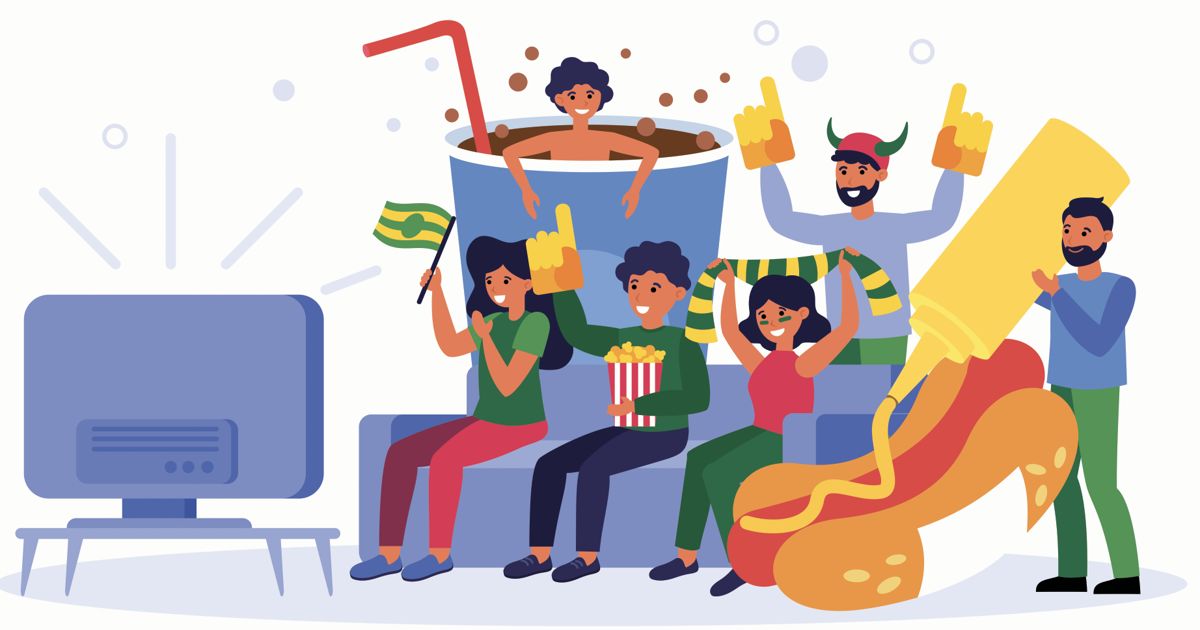From ads to experience - the evolution of Super Bowl marketing
Ben Hennes, Co-owner and CCO of Happylucky muses on how the collective experiences of Big Game and big ad viewing have morphed into a multiscreen, multi-platform mode that offer brands interesting opportunities.
The Super Bowl is known as the Big Game for a reason. Whether you’re a die-hard football fan or a die-hard diva fan, we tune into that February Sunday for the game, the half-time show, the snacks, parties, and, yes, the ads.
Ads have been synonymous with the game for decades and each generation seemingly has a handful that they remember the most – Apple’s 1984, Volkswagen's The Force in 2011, the ongoing saga of the Clydesdales, the Super Bowl blackout in 2013 and even the Coinbase QR code in 2022. Since then, the big game has exploded into a cultural phenomenon where it’s less about one singular moment and more about the surrounding conversations and the collective experiences around the game.
Why watch the game now when someone can condense hours of play – and ads – into less than five minutes?
As the Super Bowl weekend brings together family, friends and football foes, do we still experience the same togetherness during commercial breaks as when watching the game? Are we sharing the next round of ads in the way that we used to, or do we just wait for the Monday morning recap of advertising’s winners and losers?”
Credits
powered by
- Agency Deutsch/Los Angeles
- Production Company Park Pictures
- Director Lance Acord
-
-
Unlock full credits and more with a Source + shots membership.
Credits
powered by
- Agency Deutsch/Los Angeles
- Production Company Park Pictures
- Director Lance Acord
- Art Director Craig Melchiano
- Assoc Producer Brooke Horne
- Copywriter David Povill
- Dir of Integrated Pr Vic Palumbo
- Group CD/Art Directo Michael Kadin
- Group CD/Writer Eric Springer
- HP Victoria Guenier
- Producer Jim Haight
- Producer Mary Catherine Finney
- Producer Megan Dahlman
- DP Lance Acord
- Editor Jim Haygood
- Exec Producer Michael Raimondi
- Colorist Stefan Sonnenfeld
- Audio post Mark Meyuhas
- Exec Producer Mary Ann Marino
- Song "Imperial March" John Williams

Credits
powered by
- Agency Deutsch/Los Angeles
- Production Company Park Pictures
- Director Lance Acord
- Art Director Craig Melchiano
- Assoc Producer Brooke Horne
- Copywriter David Povill
- Dir of Integrated Pr Vic Palumbo
- Group CD/Art Directo Michael Kadin
- Group CD/Writer Eric Springer
- HP Victoria Guenier
- Producer Jim Haight
- Producer Mary Catherine Finney
- Producer Megan Dahlman
- DP Lance Acord
- Editor Jim Haygood
- Exec Producer Michael Raimondi
- Colorist Stefan Sonnenfeld
- Audio post Mark Meyuhas
- Exec Producer Mary Ann Marino
- Song "Imperial March" John Williams
Above: VW's The Force, directed by Lance Acord, is an all-time favourite Super Bowl ad.
Advertisers talk about this being an opportunity because, in these days of fragmented media, brands have a unique opportunity for a shared viewing experience. But with so much pre-buzz, social media is creating an immediacy and always-on-ness. Why watch the game in real time when someone can condense hours of play – and ads – into less than five minutes?
To see all of this year's Super Bowl spots with full credits and in one place, click here.
Also, as younger generations, such as Gen Z, are showing a decreased interest in football, with entertainment like anime becoming more popular than sport, are advertisers doing enough to truly make this moment a collective experience?
As we enter a post-second-screen era, will brands start to tap into a third element of shared experiences – there is such power in the fact that not only are we viewing the game on one screen, or multiple – but that we are sharing space, and community with one another.
This year, DoorDash is utilising the first and second screen, plus shared experience.
This year, will we witness brands bringing broadcast and digital elements together in order to be a part of our collective experiences. There is beauty in a brand’s ability to join in on real-time conversations and engage with people beyond a prefabricated commercial — while creating memorable experiences for consumers.
DoorDash's campaign is a great example of this approach. This year, the brand is utilising the first and second screen, plus shared experience, as they attempt to DoorDash items from Super Bowl commercials to one lucky winner – showing the increasing trend towards more interactivity with ads, even with the highly touted Super Bowl ones. But can brands go further?
Credits
powered by
- Agency Wieden + Kennedy/Portland
- Production Company Lord Danger
- Director Mike Diva
-
-
Unlock full credits and more with a Source + shots membership.
Credits
powered by
- Agency Wieden + Kennedy/Portland
- Production Company Lord Danger
- Director Mike Diva
- Executive Producer Anthony Ficalora
- Post Production/Animation/VFX Modern Logic
- Post Managing Director Michael Bennett
- Executive Post Producer Monica Reimold
- Additional VFX/Color The-Artery
- Executive VFX Producer Deborah Sullivan
- VFX Producer Thurman Martin III
- VFX Executive Creative Director Elad Offer
- Music Lord Danger
- Managing Director/Executive Music Producer Josh Shadid
- Sound Field Day Sound
- Executive Audio Producer Leslie Carthy
- Sound Designer Morgan Johnson
- Audio Mixer Noah Woodburn
- Audio Mixer Natalie Huizenga
- President Jason White
- Executive Creative Director Susan Hoffman
- Executive Creative Director Azsa West
- Executive Creative Director Felipe Ribeiro
- Creative Director Christen Brestrup
- Creative Director Bertie Scrase
- Post Producer Ashlie Iacocca
- Creative Director Dan Viens
- Art Director Eugene Guaran
- Art Director Alex Nassour
- Senior Animator David Ariew
- Senior Animator Ethan Chancer
- Copywriter Alex Maleski
- HP Orlee Tatarka
- Editor Andrew Henry
- Executive Producer Ricara Stokes
- Producer Katie Schaller
- Associate Producer Charleston Chambers
- Design Director Stephanie Ward
- Colorist Stephen Picano
- Designer Luke Wilhelmi
- Design Producer Kelly Cousins
- Designer Avery Jagre
- Designer Elena Hernandez
- Music Producer Michael Frick
- Composer David Dahlquist
- Designer Olivia Brown
- Designer Macy Eiesland

Credits
powered by
- Agency Wieden + Kennedy/Portland
- Production Company Lord Danger
- Director Mike Diva
- Executive Producer Anthony Ficalora
- Post Production/Animation/VFX Modern Logic
- Post Managing Director Michael Bennett
- Executive Post Producer Monica Reimold
- Additional VFX/Color The-Artery
- Executive VFX Producer Deborah Sullivan
- VFX Producer Thurman Martin III
- VFX Executive Creative Director Elad Offer
- Music Lord Danger
- Managing Director/Executive Music Producer Josh Shadid
- Sound Field Day Sound
- Executive Audio Producer Leslie Carthy
- Sound Designer Morgan Johnson
- Audio Mixer Noah Woodburn
- Audio Mixer Natalie Huizenga
- President Jason White
- Executive Creative Director Susan Hoffman
- Executive Creative Director Azsa West
- Executive Creative Director Felipe Ribeiro
- Creative Director Christen Brestrup
- Creative Director Bertie Scrase
- Post Producer Ashlie Iacocca
- Creative Director Dan Viens
- Art Director Eugene Guaran
- Art Director Alex Nassour
- Senior Animator David Ariew
- Senior Animator Ethan Chancer
- Copywriter Alex Maleski
- HP Orlee Tatarka
- Editor Andrew Henry
- Executive Producer Ricara Stokes
- Producer Katie Schaller
- Associate Producer Charleston Chambers
- Design Director Stephanie Ward
- Colorist Stephen Picano
- Designer Luke Wilhelmi
- Design Producer Kelly Cousins
- Designer Avery Jagre
- Designer Elena Hernandez
- Music Producer Michael Frick
- Composer David Dahlquist
- Designer Olivia Brown
- Designer Macy Eiesland
Above: DoorDash's Super Bowl competition promises to deliver products advertised throughout the game.
For brands to be truly unforgettable, their impact and voice must speak beyond a 30-second spot. It’s not just a viral moment or TikTok sound, it must be about connection – something we continue to yearn for following the pandemic.
You can make the audience laugh or cry but most importantly, make them remember.
An all-or-nothing approach isn’t going to work when different generations and audiences have diverging expectations. A modern approach to advertising marries disparate elements together; creates a collective effervescence that's built on culture, connection, and nostalgia.
It doesn’t have to be about buying a bag of chips or deciding on a car insurance, it can just be a moment. Isn’t that what most brands are looking for – a moment? And why not share that moment, evoke the formation of a memory. You can make the audience laugh or cry but most importantly, make them remember.
People are craving spectacle in their lives, and for many, the Super Bowl is that spectacle. That's why they build stadiums out of snack trays, that’s why they dream of a trip to the game they can probably never afford.
Brands have an incredible opportunity to be a part of our living room spectacles.
But how can brands be the facilitator of spectacle for the groups of friends viewing together - or at the bar packed with exuberant fans? How might your brand help your fans be their own spectacle? Figuring out how you define that in a way that ladders up to your brand purpose, your mission, your product as well as the relationship that you have with the audience will be key.
It’s time for the culture-shifting, emotion-filled moments to make their comeback, and brands have an incredible opportunity to be a part of our living room spectacles – but they must stay true to themselves and their audiences, not always as a star, but sometimes the supporting role. Because the only thing worse than being silent on the loudest stage is being the one singing out of tune.
)













